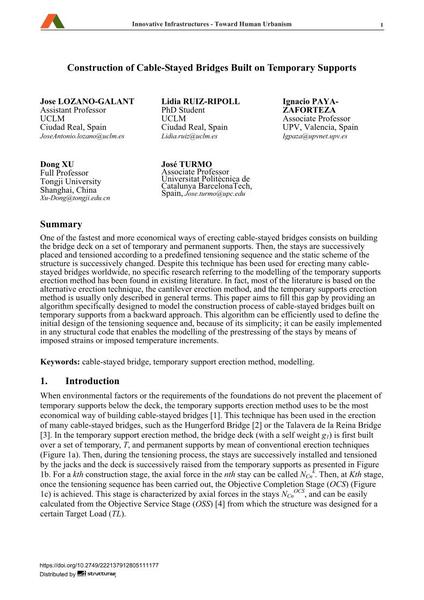Construction of Cable-Stayed Bridges Built on Temporary Supports

|
|
|||||||||||
Détails bibliographiques
| Auteur(s): |
Jose Lozano-Galant
Lidia Ruiz-Ripoll Ignacio Payá-Zaforteza Dong Xu José Turmo |
||||
|---|---|---|---|---|---|
| Médium: | papier de conférence | ||||
| Langue(s): | anglais | ||||
| Conférence: | 18th IABSE Congress: Innovative Infrastructures – Towards Human Urbanism, Seoul, Korea, 19-21 September 2012 | ||||
| Publié dans: | IABSE Congress Seoul 2012 | ||||
|
|||||
| Page(s): | 835-841 | ||||
| Nombre total de pages (du PDF): | 7 | ||||
| DOI: | 10.2749/222137912805111177 | ||||
| Abstrait: |
One of the fastest and more economical ways of erecting cable-stayed bridges consists on building the bridge deck on a set of temporary and permanent supports. Then, the stays are successively placed and tensioned according to a predefined tensioning sequence and the static scheme of the structure is successively changed. Despite this technique has been used for erecting many cable- stayed bridges worldwide, no specific research referring to the modelling of the temporary supports erection method has been found in existing literature. In fact, most of the literature is based on the alternative erection technique, the cantilever erection method, and the temporary supports erection method is usually only described in general terms. This paper aims to fill this gap by providing an algorithm specifically designed to model the construction process of cable-stayed bridges built on temporary supports from a backward approach. This algorithm can be efficiently used to define the initial design of the tensioning sequence and, because of its simplicity; it can be easily implemented in any structural code that enables the modelling of the prestressing of the stays by means of imposed strains or imposed temperature increments. |
||||
| Mots-clé: |
Pont à haubans
|
||||
